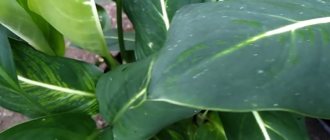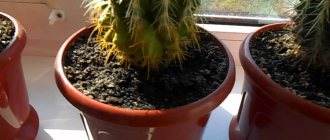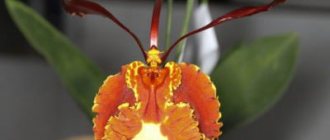- home
- Plant catalog
- Orchids
Reading time: 20 minutes
5106
Europeans became acquainted with magnificent orchids more than three hundred years ago. The first specimens of these tropical plants, which arrived from the American continent to Holland, amazed even experienced flower growers with their exquisite appearance and duration of flowering .
But in those distant times, exotic beauties could only grow in royal greenhouses. Nowadays, blooming orchids can be seen not only on the windowsills of ordinary apartments.
They fit harmoniously into the interiors of offices and educational institutions, decorate hospitals and libraries, plant greenery in the halls of enterprises and even personal gardens . The successes of flower growers in the study of orchids and the efforts of breeders allowed tropical guests to firmly establish themselves in the homes and hearts of people of the 19th century.
- General information about the Phalaenopsis orchid
- Popular varieties in home culture Phalaenopsis mix
- Phalaenopsis blue
- Phalaenopsis Philadelphia
- Phalaenopsis Stewart
- Phalaenopsis Magic Art
- Dendrobium Phalaenopsis
- Phalaenopsis mini
- Placement and lighting
- Transfer rules
- Conditions required for Phalaenopsis to bloom
- Sticky spots on leaves
Purchase and adaptation
Select a specimen with elastic leaves, without spots and drying tips. Healthy roots are succulent, green or grayish in color, without rotten or wet areas, the substrate is free of mold.
Newbie homes need to be isolated from your indoor plants. During the first 30 days, monitor it for pests. Water only after drying, when the roots become silvery, and begin feeding a month after purchase. At the end of quarantine, move the flower to a permanent location.
Popular varieties in home culture
Among the numerous varieties of Phalaenopsis, any gardener will be able to select specimens to suit their taste or based on the needs of the collection.
Interesting! The corollas of Phalaenopsis are similar in appearance to butterflies, which gives the name to the whole genus (moth-like). The color palette of flowers includes all rainbow shades, which further increases the resemblance to delicate insects.
For beginners and amateurs, we can recommend the most common varieties in home cultivation, photos of which will help you make a choice.
Phalaenopsis mix
A hybrid specially adapted for indoor culture. Requires minimal care . A large plant (height with peduncle reaches 0.7 m) with large butterfly flowers of all shades of the rainbow.
The leaves are standard for the genus - large, leathery, oval-round in outline . It blooms multiple times in one year with long periods of corolla retention.
Phalaenopsis blue
There are no consistently blue varieties in nature. Several hybrid forms and natural varieties are known with delicate and subtle tones of blue and lilac (sometimes on a white background).
All bright blue specimens sold are tinted with natural dyes using a special technology. The second flowering of such forms is usually white or pale blue , but not all sellers honestly warn about this.
Other characteristics depend on the variety chosen for tinting.
Phalaenopsis Philadelphia
A distinctive feature is large, oval-elongated leaves with a marble pattern, covered with a glossy coating. The inflorescences are of medium height and branch well . It blooms gently with lilac butterflies.
Phalaenopsis Stewart
It is distinguished by narrow, long leaves with light patterns, as well as silvery roots. Multi-flowered inflorescences - sometimes about 60 buds at a time on high peduncles (up to 80 cm) bear small white fragrant corollas.
Blooms during warm periods. Duration – no more than 30 days.
Phalaenopsis Magic Art
Not a very large orchid (about 60 cm) with oval dark green leaves . It is distinguished by brightly colored corollas: crimson droplets are scattered across the white petals, complemented by streaks of the same color.
The middle is red with crimson and yellow tints . Blooms twice a year.
Unusual Phalaenopsis are very popular in culture:
Dendrobium Phalaenopsis
Belongs to the genus Dendrobium, it received its name for the resemblance of the corollas to butterfly orchid flowers.
Dendrobium Phalaenopsis has a sympodial type of growth , that is, it can grow in width due to the formation of new shoots on the rhizome. The leaves are long and narrow. The inflorescences are formed from pseudobulbs, the flowers are white to purple in color.
Phalaenopsis mini
The Phalaenopsis mini orchid differs from other species only in its insignificant peduncle height (no more than 20 cm). It has large thick leaves of green (less often spotted) color .
Blooms both in summer and winter months. Flowers are butterflies of various shades.
Temperature
Phalaenopsis orchid is a tropical plant, the suitable average daily temperature for keeping is 20 -25 degrees. To set flower buds, the difference between day and night temperatures should be from 3 to 5 degrees.
What to do in case of different problems?
Grows from a growing point
It happens in a plant that has had many flowering cycles or has suffered stress (sharp change in living conditions). Provide the flower with proper care and in a short time the peduncle will delight you with flowering.
Broken
The young shoot is fragile and can break if handled carelessly. Do not try to re-grow it, but carefully cut it, powder the cut area with activated carbon or cinnamon powder. Make a cut near the nearest bud. After some time, a new shoot will form.
Not for a long time
It is very disappointing when a plant does not please us with its flowering. The following actions will help to shake it and provoke it to grow a peduncle:
- Move the pot to a dark place.
- Reduce, but do not stop, watering.
- Reduce night temperature by five degrees.
Measures to bring a flower out of hibernation should not be lengthy. A period of seven days will be sufficient.
Stopped growing
Such a nuisance occurs if the plant feels a lack of light, heat, moisture or is infected. Inspect it and change the growing conditions or treat it if necessary. In order for the flower to have enough strength to bloom, it is necessary to fertilize it with minerals or change the soil mixture.
Watering and fertilizers
Methods of watering orchids:
- immersion The pot is placed in a container of water;
- spillage around the edges of the pot;
- warm shower.
You can determine that moisture is needed by the color of the roots: when dry, they become silver in color. The substrate must dry completely. Use soft, settled water, otherwise salts will settle on the roots.
You need to make sure that moisture does not get into the growth point, this will provoke the development of diseases. Remove water from the outlet with a dry cloth. How and when to water a flower depends on the growing conditions.
Healthy plants are fertilized, sick and flowering ones are not. After transplantation, do not use fertilizing for a month. Fertilizer preparations are diluted according to instructions and watered well before application so as not to burn the root system.
How to choose Phalaenopsis in the store
In order for the orchid to quickly adapt to its new apartment conditions and feel comfortable, when purchasing a plant you should take into account some nuances:
- It is possible to determine the color of a future pet only in a blooming state. In addition, blossoming buds without disturbing the richness of color , firmly sitting on the peduncle, will show a healthy plant. – Buy an orchid during flowering.
- A sick plant will be revealed by its root system: if the roots are sluggish, with spots of rot, and the orchid sways in the pot when touched, then you should not buy it (the flower is weakened). – When purchasing, check the health of the roots.
- A healthy orchid certainly has powerful, fleshy leaves . They should not have cracks, scratches or dry areas. Most varieties have dark greens. – When buying an orchid, pay attention to the leaves.
Lighting and Humidity
The process of photosynthesis requires light. It is important to choose the optimal lighting intensity. Under natural conditions, representatives of the species grow under the forest canopy, in the shade, and in the direct rays of the sun in summer, leaves and roots can get burned.
When growing tropical beauties at home in winter, special phytolamps are used for additional lighting.
If it is necessary to increase air humidity in the summer heat, or in winter during the heating season, place a container of water next to the plants and use air humidifiers.
Reanimation
Maintenance errors can most often lead to loss of roots, lack of leaf turgor, and premature falling of flowers and buds. Such plants will need resuscitation.
If leaf turgor is lost due to untimely watering, periodic bathing in well-warm water and increasing air humidity can save the situation.
In case of partial or complete loss of roots, it is necessary to replace the old substrate, temporarily stop watering the pot and replace it by spraying the surface of the substrate. If there are no roots at all, you can place the rosette in a bowl with damp moss.
Such flowers will have to be fertilized and watered leaf by leaf.
You can grow roots on damp moss.
You will learn more about the resuscitation of phalaenopsis from this article. In this article you will find complete information on how to grow plant roots.
Caring for sick plants
Resuscitation also includes caring for sick flowers. However, if we are talking about a plant being damaged by diseases and pests, then it is necessary to treat it with special preparations and keep such a specimen separately from other plants until complete recovery.
It is also recommended to keep phalaenopsis that were recently purchased , since in a store with a large concentration of plants there is a high probability of infection with diseases and pests.
Read this article about how to properly care for plants after purchase.
Bloom
Phalaenopsis in the wild has its own development cycle. In natural habitats, the rainy season gives way to the dry season, and the time for flowering begins. With proper care indoors, the orchid grows leaves and roots, then a peduncle forms.
To keep it erect, as it grows, it is tied to a support. At this time, the development of the vegetative mass stops; no fertilizing is necessary. The blooming buds show off for several months.
If the peduncle remains green, it should not be cut. The remaining buds can form new shoots.
Phalaenopsis diseases
Diseases can be caused by errors in care, fungi or bacteria.
Sticky spots on leaves
If the plant suffers from uncomfortable conditions, sticky drops may appear on the leaves of the Phalaenopsis orchid. These glue-like droplets give a signal to revise your care regimen.
But sometimes the drops appear as protection against pests or as a means of attracting pollinators . In these cases, there is no need to worry.
Decreased leaf turgor
If the question arises: how to restore leaf turgor in a Phalaenopsis orchid, you should care for the plant based on the reasons that caused this problem .
Loss of turgor is also caused by improper care: compacted soil, overheating of the underground part, uncontrolled watering. The cause should be found out and care adjusted .
Hives
Phalaenopsis disease is characterized by small spots (up to 3 cm) on leaf blades.
The reason lies in the cold and too humid air of the room without sufficient ventilation. To combat urticaria, it is enough to change the conditions of care.
Fusarium
A disease that is dangerous for an orchid is caused by fungi that have entered the roots and base of the stem through the soil. Causes rotting of the underground parts of the plant, which gradually spreads to the above-ground parts.
Carefully! Fusarium can only be treated before rot appears, so when pinkish-white dust particles are first detected, the orchid is quarantined and treated with fungicides.
When plants rot, they must be destroyed to prevent mass infection.
Botrytis
A fungal disease characterized by brownish and black speckles on buds and flowers. It occurs due to moisture getting on the petals and in the axils of the leaves.
Botrytis disrupts the decorative effect and, without treatment, can lead to the death of the orchid. To cure, the affected parts should be removed and treated with a fungicide .
Please also pay attention to the beneficial effect of succinic acid on orchids both for diseases and for prevention.
Phalaenopsis pests
Of the parasites that affect Phalaenopsis, the most dangerous are thrips , spider mites, scale insects, mealybugs and slugs. Measures to combat them include preventive examinations and treatment with insecticides when infected.
Love your Phalaenopsis orchid, take care of it, and the orchid will respond with magnificent blooms .
This video talks about mistakes in caring for the Phalaenopsis orchid and how to grow a healthy plant.
Transfer
After the end of lush flowering, you can begin the transplantation procedure. Usually the reason is the removal of transport soil or the growth of the root system, the need to replace salted pieces of bark.
To ensure the process of photosynthesis in the roots of the epiphyte, the substrate must be:
- loose;
- moisture-absorbing;
- breathable;
- light.
You can find a ready-made mixture for orchids on sale. The composition includes: the main component is pine bark, sphagnum, charcoal, coconut chips or fiber, peat. If the soil is prepared independently, it is important to consider the following points: the collected bark must be disinfected and the resin and tannins removed from it.
Choosing a pot is another difficult task for a novice gardener. The best option is a transparent container with many holes for water drainage and root aeration.
The assortment on store shelves is presented in the following options:
- plastic transparent pots - simple, with drainage holes;
- colored translucent - the light necessary for the roots penetrates them;
- “crown” system - more suitable as a flowerpot for a pot;
- ceramics or glass - delicate roots grow to the walls, you need to properly regulate the amount of moisture in the soil; this growing method is not recommended for beginners.
During transplantation, the plant is removed very carefully, trying not to damage the fragile roots. Thin threads without velamen, blackened areas are removed with a sterile instrument.
Check to see if there is a plastic cup under the neck; if it is in the way, it should be carefully removed. The roots are distributed in a new pot, the aerial ones are also placed, if possible, and the substrate is added.
And then they simply leave the transplanted plant alone and give it time to adapt. Abundant watering and fertilizing during this period will have a detrimental effect.
Recommendations for care
Creating the right environment is very important:
- The most important factor for phalaenopsis is light. In natural conditions, the plant lives under the canopy of trees, so although they need a lot of light, it should not be direct sunlight.
- The second most important factor is watering; you can’t overdry them, but this doesn’t mean you need to water them. The humidity in the room is not important for phalaenopsis, the main thing is proper watering.
Unlike other types of orchids, phalaenopsis does not require annual replanting, special fertilizers, or daily spraying. But a newly purchased plant needs special care. In a new place, the plant begins a period of adaptation . Its leaves and buds may begin to fade.
Even after a thorough inspection in the store, phalaenopsis can carry parasites, so it needs to be isolated from other plants for a couple of weeks. If everything is fine with it after quarantine, you can place it next to other flowers.
If you find salted bark in a pot, remove it immediately. Make sure that there are drainage holes in the pot; if there are none, make them, but do not damage the roots.
The plant should only be replanted if the plant looks sick . damage is visible on the roots or it falls out of the pot.
It is necessary to accustom phalaenopsis to light gradually; do not immediately place it in a brightly lit place.
Reproduction
The first purchased specimens have taken root in the apartment, they delight us with their flowering, now it’s time to master the techniques of propagating graceful beauties.
In its natural habitat, the ornamental crop reproduces by dusty yellowish seeds. At home, if you have a strong desire and patience, you can take care of flowering plants, carry out pollination yourself, and collect seeds after 5-6 months. Growing seed material is carried out in a prepared sterile environment; the process is complex and lengthy for breeders and advanced collectors.
Other propagation methods:
- children;
- cuttings from flower stalks.
Children appear on the peduncle, on the trunks (if the main growth point has died), between the leaves. The babies are not separated from the mother plant until they have grown several leaves and their own roots to ensure independent life.
After flowering has finished, cuttings are cut from the peduncles. They can be rooted in homemade plastic greenhouses. If successful, the root formation process lasts about a month.
Questions about content
Next, we will answer some of the most common questions about how to care for phalaenopsis (phalaenopsis).
How do you know when it's time to water?
If an orchid grows in a transparent hill, then you should pay attention to the color of the roots.
Beginners should place a wooden skewer or long sliver of wood in the center of the pot when replanting. Before watering, you need to pull it out and look at its condition.
If the skewer is wet, then watering should be postponed.
How to care for a painted plant?
Caring for painted phalaenopsis is not particularly different , but the viability of such plants is much lower due to the influence of the dye. When purchasing, it is better to choose a plant with a natural color, because over time, blue or dark blue flowers will inevitably turn white.
Do you need lighting in winter?
Phalaenopsis can easily survive the winter without lighting, but poor lighting can still stunt growth and delay flowering. To avoid this, you can use special phytolamps to increase the length of daylight hours.
Orchid lighting.
How to wake up phalaenopsis?
Sometimes the plant freezes and stops growing. Often this phenomenon occurs due to unfavorable conditions, for example in winter with a lack of light and lower temperatures . When conditions improve, phalaenopsis begins to form new leaves again.
Such periods of rest are quite normal. The flower cannot grow continuously and requires short breaks to gain strength to grow new roots and leaves.
What should be the care during flowering?
Care during flowering is not much different from normal daily care.
However, you should try to move the orchid less and rotate it around its axis while the flowers are blooming, and also avoid drafts and moisture getting on the flowers.
You can prolong flowering a little with the help of special fertilizers.
Do you need LED phytolamps?
Special lamps can be used when there is a severe lack of natural light. If the light mode is normal, then there is no need for lamps. However, in winter, when light levels are low, phytolamps will help stimulate flowering and not stop growth.
Rejuvenation
In an elongated bush with a large number of aerial roots, the upper part with leaves and roots is cut off with a sharp sterile pruning shears. Leaves are also left on the mother plant; children will develop on the old trunk.
The cut part is dusted with crushed coal or cinnamon, dried, and planted without deepening so that the root collar does not become damp.
A detailed description and step-by-step instructions with photos for propagating the Phalaenopsis orchid can be found on websites for gardeners; it’s easy and exciting.
What kind is this?
Phalaenopsis is a herbaceous plant belonging to the Orchid family. Under natural conditions it grows in hot climates with high humidity, mountain and lowland forests.
The plant grows straight up, reaching 50 centimeters . There are a great many color variations, from plain to two-color, striped, etc. The flowering period is from 2 to 6 months, sometimes it can bloom 2 times a year. An adult plant has 4-6 leaves; two large fleshy leaves grow in a year.
Phalaenopsis got its name because the flower resembles a fluttering butterfly.
Errors in care
The most common errors:
- watering with cold, hard water;
- frequent watering without breaks for drying;
- choosing the wrong place - lack or excess of lighting, drafts;
- overdoing the application of fertilizers.
After eliminating these errors, the orchids will thank you for your attention with a wave of luxurious flowering.
Watering frequency by period
During different periods of the life of the phalaenopsis orchid, it requires different watering regimes. Flowering, more active growth and even wilting can depend on this factor.
Each period has its own watering frequency:
- During the period of active growth, the orchid is watered once every 5-7 days, depending on the conditions of the surrounding microclimate;
- In order for the stem to begin to expel the peduncle and have more buds on it, it is effective to use a warm shower, which will imitate the flower’s natural living conditions;
- Gradually, the flowers on the arrow bloom , this should become a sign in order to shorten the breaks between waterings. Now the phalaenopsis orchid will need watering every 2-3 days. In addition, a warm shower is not canceled, which will prolong flowering;
- After removing the peduncle, the overseas beauty needs to be given time to rest. To do this, the replenishment of moisture reserves is reduced, watering is done once every 10-12 days. Sometimes you can foliar feed the plant by spraying.
Important! It is worth remembering that from an excess of moisture, the roots of an orchid can easily rot. It's better to underfill than overfill.
Photo of Phalaenopsis Orchid plant
Flower birthplace and origin
In nature, these plants can be found in Asia, Australia, the Philippines, and in places with a humid tropical climate.
The genus owes its name to K. Blume, the director of the botanical garden, who at dusk mistook an orchid flower for a butterfly. Phalaenopsis is a Greek word meaning “moth-like.” And indeed, in its shape it resembles this fragile creature.
In Ancient Greece they saw another similarity, with a slipper or shoe. However, such elegant shoes are not suitable for earthly creatures. She is worthy only of the feet of the Goddess of Beauty. Hence the name - Aphrodite's slipper.
Description of the plant
Phalaenopsis is an epiphytic plant of the Orchidaceae family.
Orchid grows on tree trunks and even rocks
The roots of Phalaenopsis both in their purpose and in structure. They are divided into main and subordinate ones. With the help of the main roots, the plant is attached to the tree trunk and always grows vertically, upward. Adventitious roots are located between the leaves and are aerial.
Sometimes they look very exotic, forming a “beard”
Like leaves, roots are capable of photosynthesis. This explains their unusual gray-green color for roots and their special structure, reminiscent of the tissues of succulent leaves that can retain moisture.
Orchids have a short stem with sessile large (from 7 to 30 cm) dense leaves of a rounded elongated shape located on it in pairs. On adult specimens there are from 4 to 6. During each year, 2 leaves appear, increasing the overall height of the plant.
The flowering of a plant begins with the appearance of a peduncle. It can branch, stretching up to 70 cm, and bears a large number of buds.
Thanks to the sequential opening of the buds, the flowering of orchids lasts for several months.
Phalaenopsis
The flower consists of 3 lateral sepals (sepalia), 2 lateral petals (petalia) and a central part, the so-called lip. Its task is to attract and accept, like a “landing site,” pollinating insects.
Phalaenopsis flowers can have the most incredible shapes and colors
Agricultural technology
All reasons associated with withering, poor growth or even death of the plant are associated with ignorance of the rules of care and agrotechnical cultivation techniques.
Planting or transplanting
Ideally, the transplant should be done so that the orchid does not notice it. No fading or stress should occur. But in reality, there will still be stress.
Transplantation should be done immediately after purchasing a new hybrid. And fill the new container up to the leaves. Those. deepen by 2-3 cm.
It is in this place that new roots will begin to grow. Nothing new will appear in the old rhizome.
Also, when replanting, you should replace the commercial moss and filler with new ones. That moss is already pretty greasy and the plant will feel uncomfortable.
After transplantation, the leaves should not be exposed to sunlight until complete rooting. But the illumination must be full and sufficient in duration.
The purchased orchid is carefully removed from the pot and freed from the old filler. The substrate sprouted into the roots is not torn off and the roots do not unravel. Rotten and dry roots are cut off. Yellow roots are considered normal and should not be removed.
The bottom of the container, which should be slightly larger than the diameter of the root system, is filled ¼ with clean bark, and its largest fraction is placed on the bottom.
The substrate should not be compacted. It is compacted by tapping the wall of the container or shaking it. The orchid must be located in the center of the pot and stand strictly vertically, regardless of the root system and peduncles.
Holes should be made in the bottom of the pot. It is best to soak clean bark for a couple of days before planting. Do the same with a substrate or a special purchased mixture - moisten it, let the water drain and dry it a little.
If the bark is fresh (does not take up moisture), there is a danger to the plant. To do this, it is mixed with moisture-intensive components, such as sphagnum moss or coconut chips. It is possible to boil the bark for 12-15 hours. Then it is planted in a moist substrate and watered.
Watering
Phalaenopsis needs a slightly moist substrate at all times. Overdrying threatens his death.
There are no specific watering intervals for it. It all depends on temperature, humidity and light. But it should always be slightly damp. You can deepen your finger 5 cm and check the moisture.
It is necessary to learn to determine the timeliness of watering , avoiding drying out or waterlogging, and then it will grow and develop safely.
Do not allow the substrate to dry out or become waterlogged.
Nutrition
Only rooted and actively growing plants are fertilized . Feeding during dormant and cool periods is harmful. Nutrition is introduced from April to September, during the period of active development. Additional nutrition must be added strictly according to the manufacturer's instructions. Otherwise, it will only bring harm.
Advice! Fertilizer should not be used when replanting a newly acquired hybrid.











